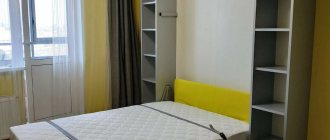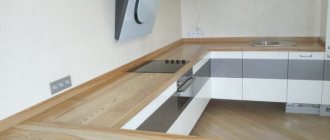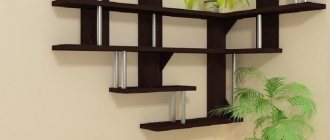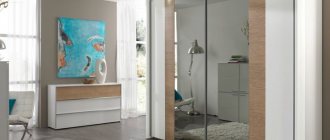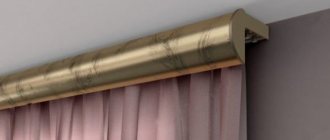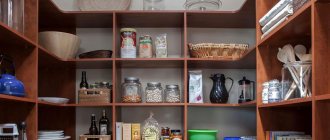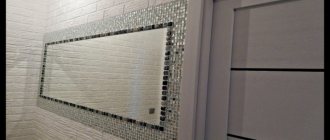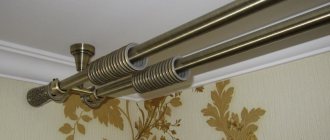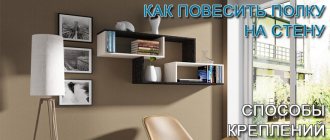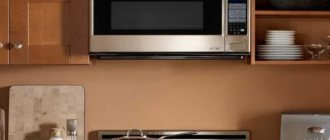Drywall is a universal building material that is in great demand. With its help, the easiest way to create partitions in a house or to level the walls in an apartment. It is easy and convenient to work with, which is why it is often chosen by craftsmen during repairs to perform the work listed above. However, the material also has its own characteristics. One of them is its rather low strength, and therefore it is not so easy to hang anything on walls made of this material. But still possible. How to hang a cabinet on a plasterboard wall? Let's figure out how to solve this problem.
How to hang a cabinet on a plasterboard wall
Method 1. Installation of embedded beam
The embedded elements are pre-installed into a wall or partition made of plasterboard at the required height during the installation of the frame.
A huge advantage of this method is the ability to securely screw the cabinet fastenings anywhere along the entire length of the embedded elements.
Mortgages do not require any additional costs. Essentially, these are additional horizontal jumpers of the frame made from scraps of a rack profile with wooden blocks embedded in them.
The combination of profile and timber has a number of advantages compared to purely wooden mortgages:
- There is no need to select a beam that is ideally suited to the thickness of the partition - the profile will set the required thickness of the frame. The pieces of timber are screwed to it with self-tapping screws during the installation process and do not dangle;
- The metal “shirt” from the profile protects the timber from cracking and provides additional rigidity.
The method with embedded elements is often used if it is necessary to hang kitchen cabinets (especially on a plasterboard partition), when there is simply no possibility of attaching to a solid wall.
Installing mortgages is the most reliable way to hang a cabinet on a plasterboard wall.
The disadvantage of this fastening method is the need to know in advance the dimensions and location of the wall cabinets, which is not always known at the installation stage.
Using profiles for other purposes
Each type of plasterboard profile has its own purpose. Sometimes a ceiling profile is used instead of a rack profile, this leads to the fact that the partition structure turns out to be fragile. In addition, this is associated with difficulties in work, since sheets cannot be attached to the ceiling profile on both sides. It is not recommended to bend profiles, cut or change their geometry.
This error is due to the fact that the use of ceiling profiles is allowed when covering walls or when creating boxes for shelves, a fireplace or a TV.
Ceiling profile partition.
Read more about the types of profiles for fastening drywall in the article “Profile for drywall: a brief educational program”
How to attach kitchen and other hanging items to gypsum boards?
The following describes how to attach furniture in the kitchen and other rooms, including sliding wardrobes with hinged mechanisms or other models, to a plasterboard surface.
Installing the horizontal mounting rail for the bracket
One of the popular ways of attaching furniture to HA sheets is to install a horizontal rail for brackets with hooks. Such metal strips are included with modern kitchen units.
The metal bus is a longitudinal metal rail of different widths with many holes drilled in it at a distance of 5 cm from each other, and bends for hanging modules on hooks. The rail is attached to the wall, its position is leveled, and then the assembled module is hung on it.
Fastening cabinets to a mounting rail is more reliable than other methods. When hanging, there is no need to hold heavy modules suspended in order to mark locations for future holes. Furniture hung in this way does not have contact with the wall; the weight is distributed over a pre-fixed rail, increasing the reliability of the suspended structure.
Installation is carried out by combining two methods:
- The tire is attached to the metal profile posts through a plasterboard sheet.
- Where there are no profile guides, dowels are screwed in.
The second way to detect the frame is test drilling. The drywall is drilled in several places with a thin drill without pressure. The height must be chosen in such a way that the test holes are later covered by the suspended tire.
They can also be bars and planks of wood. However, such material has its drawbacks. Compared to a metal strip, a wooden block will be thicker, so the hanging modules will move significantly away from the walls. To compensate for this gap, a strip of similar thickness will need to be installed under the bottom of the cabinet. This will prevent the headset elements from tilting forward.
How to hang on anchors?
Anchor fasteners are more difficult to install, but more reliable. When the fastener is tightened, the inside of the dowel is compressed, so that even a strong and sudden load will not be able to pull it out of the wall. The method is suitable for hanging cabinets, for attaching ceiling lamps to a ceiling finished with gypsum plasterboard - one anchor fastener can withstand a load of up to 35 kg.
Structure of expandable anchor fasteners for walls with voids:
- A dowel made of plastic or metal with “petals” that open when the screw is tightened.
- A screw or self-tapping screw of the required length and diameter.
Most often, during installation work, two types of anchor fasteners are used:
- “Molly”, in which both the screw and the dowel are made of metal.
- "Butterfly". Has a plastic dowel and a metal screw.
To install them, you need to drill a hole in the intended place equal to the diameter of the screw, insert a loose anchor into it (the lip at the end of the dowel will prevent it from falling in), then screw the screw into the dowel using the fastening lugs.
For anchors in permanent partitions
This method is suitable for solid walls that have been covered with plasterboard. It is not suitable for partitions. The advantage of anchoring is that it allows you to hang massive structures (household appliances or heavy modules) on plasterboard walls. An anchor is a dowel made of metal or plastic, a long screw or a special threaded hook.
It is possible to hang cabinets that are expected to bear increased load during operation only if the distance from the drywall to the main wall does not exceed five centimeters. With a greater distance, even extremely thick screws can bend over time. If the distance is greater, it is recommended to use a combined method by securing the tire to the anchors and adding additional fastening points to the drywall.
When the anchors are installed, the pre-cut pieces of drywall are installed back, and the joints and seams are sealed with putty. Anchor fastening is most effective when the main wall consists of brick or concrete. In other cases (when using aerated concrete, cinder blocks and foam concrete), the reliability of fastening is significantly reduced.
Unique engineering board Bentline SUPERBASE
Solid board is a popular floor covering that is often chosen, but this coating has its drawbacks: in the Russian climate, the board often begins to dry out, which leads to warping, the appearance of gaps and cracks. Moreover, the thicker the boards, the greater the effort that occurs when they dry out.
But there is a solution - this is a perfect version of an engineered board with a unique design and SUPERBASE fastening system!
Bentline engineered board has a 2-layer construction, with a SUPERBASE fastening, which no other manufacturer has. It is specially designed for the conditions of the domestic climate with sudden changes in humidity and temperature conditions.
Fastening objects to drywall: features
If we are talking about hanging a simple picture or some light decor on a plasterboard wall, then there is no need to worry about whether the material will withstand the additional load. Sometimes you just need to screw a self-tapping screw into the sheet itself and that’s it - that will be enough, and nothing will fall anywhere. Screwing self-tapping screws into drywall is simple, no more difficult than into wood, and the material does not crack or collapse.
To hang a kitchen cabinet on the wall, for example, to fix it on drywall, you need to prepare a strong mount
However, due to the fact that drywall is far from the most durable material, it is not so easy to hang heavy objects on it. More precisely, there are no particular difficulties in the process, but there are certain features of carrying out such work and rules that must be followed. Otherwise, there is a great risk that the same kitchen cabinet or heavy shelf, if not fixed correctly, will simply fall down, at the same time ruining the drywall itself. There are certain ways to attach cabinets to such surfaces, and it is them that we will now study.
Fastening light items to gypsum boards
No hangers
When creating a suspended ceiling, it is not recommended to skimp on hangers. Fastening without the use of hangers is often used when they want to install a frame on an uneven base; this temptation is especially great when working with wooden coverings.
As a result of such installation, the profile loses its mobility - due to shrinkage deformations, cracks may appear on the surface of the drywall. In addition, when rigidly fixed to the ceiling, the main advantages of a suspended structure are lost: the ability to level the surface, hide communications and additional insulation inside the ceiling.
Plasterboard ceilings are mounted on an anchor or direct suspension. Read more about installation methods in the article “Drywall - ceiling installation”.
Installation of decorative shelves and paintings
Heavier objects should be hung using special fastening devices.
Up to 10 kilograms
With such a load on the plasterboard surface, the ideal solution would be to use a “butterfly”. This option is a dowel consisting of a plastic sleeve with two spread legs on a rod and a threaded screw.
The product is attached according to the following diagram:
Based on the size of the sleeve, a suitable drill bit for a screwdriver or drill is selected. Mounting points are outlined. The tool attachment is directed strictly perpendicularly. The resulting hole should be smooth, without deformation of the edges
To prevent such damage, you need to correctly set the power of the drill. The legs of the plastic element are straightened, and the sleeve is carefully inserted. It is not recommended to press hard, as the gypsum board may be damaged. To completely sink the product, a hammer is used, since there are two protrusions at the neck that fix the position of the part. The screw is screwed in. Due to this, on the reverse side the paws rest against the sheet.
Due to this, on the reverse side the paws rest against the sheet.
After installing all the mounting points, you can hang a picture or mirror.
To use a standard butterfly mount in a plasterboard wall, you need to drill a hole with a diameter of 8 mm
Up to 30 kilograms
It is recommended to fasten massive objects that create a load of up to 25–30 kg per fixation point using a special dowel - Driva. Its structure is similar to the previous version, but the plastic element has a “snail” shape. The part is equipped with a sharp tip and thread located on the surface of the body. A special screw is used for fixation.
Fastening a shelf or other item is carried out according to the following algorithm:
- Installation points are marked and holes with a diameter of 6 mm are drilled. It is taken into account that the seat must be exactly perpendicular to the surface.
- After preparation, you need to screw on the plastic elements. This will require some effort, because the snail thread cuts into the structure. A screwdriver will make the process much easier. The neck of the dowel should be almost in the same plane with the wall.
- Depending on the fastening device of the item being hung, installation occurs by installing and tightening the screw.
Driva fastener installation diagram
It is taken into account that Driva is divided into categories: for plasterboard bases, plastic options are recommended, since metal ones do not provide reliable installation into such a surface.
Installation of decorative shelves, paintings, light lamps
For these purposes, using dowels with a butterfly end does not make sense, but you cannot use a simple self-tapping screw either. In the first case, the fasteners will be too massive, in the second, unreliable. If the self-tapping screw is only screwed into plaster, it will quickly become loose, destroying the material. Even if it hits the profile, sooner or later the fastener will begin to reach.
You should use a special dowel for drywall. It has the shape of a truncated cone and wide-profile threads with a large pitch. The diameter is often up to one centimeter. These dowels are called DRIVA or snail dowels. There may be dowels with or without a drill at the end, metal or nylon.
For drywall, DRIVA nylon dowels with a drill at the end and a length equal to the thickness of the drywall sheets on the wall, no more and no less, are best suited. They have a cross-shaped groove at the end for easy tightening using a Phillips screwdriver.
- The locations of the fastenings are marked at the central points.
- Using a screwdriver and a cue ball with a cross-head bit, screw in the dowel until it stops.
- A shelf or other element that needs to be secured is leaned against and a self-tapping screw with a press washer is screwed in.
It all comes down to using only special fasteners for drywall, which are not more expensive than usual, but provide reliable fastening and do not create preconditions for cracking and destruction of the gypsum inside the material. You can hang almost anything on drywall, as long as you take into account its strength and follow simple instructions.
Do not forget that during drilling a large amount of dust is generated, especially considering the composition of a material such as drywall. You will need to worry about protecting the room from dust, as well as personal protective equipment when carrying out such work. You can attach shelves to a plasterboard wall using special dowels.
Such fasteners can be of various types, but one of their advantages is that when screwed into the wall, they begin to open, thereby forming sufficient support and taking on a significant part of the load. To secure such shelves, a special design will be required; firstly, it will be necessary to mount the structure strictly in the profile of the plasterboard sheet, and secondly, the use of special fasteners.
- Its installation will require quite a bit of time;
- Thanks to the use of dowels, it is quite durable as long as the shelf is used properly.
Advice! The screws are screwed in with a screwdriver, but not completely. The final screwing must be done with a Phillips screwdriver, with a little force.
- Glue – you can glue a light weight shelf, which will serve as a decorative element. This could be a shelf with a figurine of “Venus”, with a small beautiful picture;
- Dowel-nails - the shelf can be made of lightweight material. It is possible to put car and apartment keys, a mobile phone and other light essentials on it;
Typically, plasterboard walls are sheathed in one layer. The sheet thickness is 12.5 mm. When you are renovating a room, think in advance about whether there is a need to place heavy objects on such a wall. If yes, then do not skimp on making the wall with two layers of gypsum board.
Then its resistance to shelves, equipment or paintings placed on it will almost double. We select the size of the dowel based on the dimensions of the protrusion and the expected mass of things that we plan to place on it. The larger both parameters are, the longer the dowel - a nail will have to be used
Today we will talk about how to attach a shelf to a plasterboard wall if the plaster crumbles and cannot withstand this kind of load? Important! If the dowel is difficult to drive, bends or breaks, take another drill or drill a hole. The dowel should go to the full depth of the hole. Today, not only ceilings are sheathed with plasterboard, but also walls are leveled.
Although this material has a number of advantages, it still has a small drawback - fragility when hanging heavy objects on it: shelves, cabinets, paintings, etc.
Today, not only ceilings are covered with plasterboard, but also walls are leveled. Although this material has a number of advantages, it still has a small drawback - fragility when hanging heavy objects on it: shelves, cabinets, paintings, etc.
Therefore, the question very often arises: “how to hang a shelf on drywall”? Pay attention!
The drawing must indicate not only the dimensions of the wall and the shelves themselves, but also the distance between them, as well as the distance to the floor. When creating a diagram, you need to take into account both the placement of shelves on the wall and their functional purpose.
How to Install a Heavy Kitchen Cabinet on Drywall
If you have moved to a new apartment where the partitions are made of plasterboard or the main walls are sheathed with this material, and hanging cabinets cannot be avoided, determine the location of the frame inside the wall. This is quite simple if the walls are not already puttied. But what to do if they already have decorative trim? In this case, a regular magnet will help you.
Next, choose the mounting method. For example, if the distance between the hinges of the cabinets does not coincide with the pitch of the frame racks (in most cases it will not coincide, since the racks are attached in increments of 30-50 cm, and the cabinet width is 80 cm), and the crossbar is installed at an inappropriate height , you will need a rail. It is attached to the sheathing, and modules are already hung on it. In this case, the entire load is taken by the frame racks.
If you have a 40 liter aquarium or something very heavy in your kitchen cabinet, it is better to be safe with anchors. These are long bolts that are screwed into the base wall. In this case, it will bear the main load.
You can use cables suspended from the ceiling (if it is not made of plasterboard). Ideally, it is recommended to secure the cables to the supporting beams.
Let's consider these and other methods in more detail.
At the stage of installation of the frame, no attachments were made for hanging things
If you plan to use drywall in finishing work, then you need to immediately think about hanging heavy things, because to secure them inside the frame you need to make embedded parts from wood or plywood. Embeds are a reliable guarantee that a TV or shelf will not fall off the wall.
An example of using mortgages to install a TV.
How to hang a heavy cabinet in the kitchen
To hang heavy furniture in the kitchen, you need to use fasteners that can support the appropriate weight. One of these is Harmut Knauf. It holds up to 55 kg weight. To fix it you need:
- make a hole in the plasterboard surface measuring 13 mm;
- take the “Harmut” by the blue antennae and insert the metal bar at the end into the hole;
- By pulling the antennae towards you and aligning them, the bar will become horizontal on the back side. Will rest against the surface;
- on the front side, the antennae are fixed with plastic fasteners and cut off;
- A screw is inserted into the hole created from a plastic sleeve and tightened.
This type of fastener is durable. The weight is distributed over the entire plane of the back side of the gypsum board.
Another fastener that will help in hanging heavy furniture is “Driva”. The plastic dowel can withstand 25 kg, the metal model 32 kg. It can be used when a plasterboard wall is created using the frameless method. There is a drill at the tip of the fastener, so it is not necessary to use a power tool.
Before fixing the fastener in the surface, you need to find out its characteristics and how much weight it can withstand.
How to attach
For hanging a kitchen set on a plasterboard surface, there are 2 mounting options.
- The first are wooden blocks, fixed during installation of the metal frame. These bars are fixed to the rough surface, and the distance from the flow is recorded. Afterwards, markings are made on the finishing coating and dowel-nails are inserted into the wood through the drywall. All the weight from the set falls on the tree. The surface does not deform or break.
- The second option is a horizontal metal rail and wooden planks. Before fixing the tire, markings are necessary. It is necessary to select fasteners for the metal strip, because the set will be hung on it.
If there are no tires, the mortgages are not exposed, then take wooden slats and fasten them at the top and bottom (for the evenness of the cabinets). All kitchen cabinets are hung on these slats.
Connecting profiles with self-tapping screws and a press washer
The rack profile is inserted into the guides; self-tapping screws are sometimes used to fasten them together. The most unfortunate solution is to use a self-tapping screw with a press washer. The head of such a self-tapping screw will stick out strongly on the surface of the profile. It will not allow the sheet of drywall to be placed evenly on the wall.
A self-tapping screw with a press washer does not allow the sheet of drywall to rest completely against the frame.
Many beginners believe that the stronger the connection of the profiles, the more reliable the final plasterboard structure will be, but they forget that the main part of the rigidity is provided by the sheet itself, which holds the frame together. If the gypsum board does not adhere sufficiently, the strength decreases.
Kitchen wall cabinets
Kitchen design requires the placement of cabinets, shelves, hoods, air conditioning and ventilation systems, cornices, paintings, photo frames, kitchen appliances and utensils.
Kitchen modules
Objects with a small mass of up to 5 kg are hung using “Driva” and “Snail” dowels. They have elements for making holes and cutting threads in drywall yourself. Screw them in with a wrench or screwdriver. The hanging kitchen furnishings are applied to the wall, the fixation points are marked, the cross head of the wrench is inserted into the head of the dowel and a hole is drilled.
When installing a massive kitchen cabinet, they resort to methods without relying on a plasterboard wall. If the partition has already been installed or the wall is lined with gypsum board, and it is absolutely necessary to hang the cabinet, the support load is redistributed to the frame of the structure; for this, a metal profile is found using a magnet.
https://youtube.com/watch?v=D2LeJS3CrGk
Next, the cabinet is inspected; if it is discovered that the hinges do not correspond to the distance between the metal frame slats, they are twisted or an additional intermediate rail is mounted to the wall, and the cabinet is attached to it.
The choice of material and parameters of such a rail are dictated by the operational load of the modules and their own weight. Professionals use wide and long slats to redistribute the supporting load and protect the drywall. To prevent distortion, a thrust rail of the same thickness is mounted below.
Designs with a combination of a metal frame and gypsum plasterboard have many advantages. However, due to the fragile structure, there is a problem with how to hang heavy objects, such as kitchen cabinets, on drywall.
This problem can still be solved if the material is mounted on a load-bearing wall using gypsum glue. But with frame structures everything is different; knowledge of the nuances of the material, and methods of fastening, of this or that element of furniture is required, and whether they can be used under specific circumstances.
Why is it better to build a house than to buy a ready-made one, especially if this house was built for sale.
Why is it better to build a house than to buy a ready-made one, especially if this house was built for sale.
The beginning of this story was absolutely ordinary.
In a newly purchased residential building, one heating radiator was not heating. The plumber who had been called before “improved” this radiator by removing the control valve and stupidly installing a plug in its place. Remember how Celentano repaired the car in “The Taming of the Shrew”, since then he has had many followers
Source: homemasters.ru
Link to article
There is nothing difficult about hanging kitchen equipment on concrete walls. A strong base can withstand any weight, and the reliability of such fastenings is beyond doubt. Another thing is a fragile plasterboard wall, which itself is held on by thin screws. Hanging massive kitchen cabinets on it seems unrealistic. But since there is a need for this, we need to find a way to securely fasten it. Let's do this together, taking our time and wisely using modern fastening systems.
DOCKEL DESIGN MATTERS
When choosing a method for installing kitchen modules on plasterboard sheathing, we take into account their own weight and the payload that they are intended to carry. For this purpose, special dowels and devices are used, ingeniously invented by smart specialists.
We had to come up with something special because a regular dowel-nail in drywall does not work, or more precisely, it works very weakly: the expansion of the dowel begins in that far part that does not contact the drywall, but simply hangs in the air.
Let's take a closer look at this fastener, which is produced in a wide range with a diverse range of models. It must be said right away that all the declared parameters of the manufacturers of this fastener apply to a standard 12.5 mm thick plasterboard sheet. When using drywall of a different thickness, you need to make adjustments to the load-bearing figures.
RELIABLE MOLLY DOCKEL
Great for hanging cabinets. It is designed specifically for drywall and consists of a metal sleeve with a neck and a separate middle section, as well as a retaining screw. To install it in drywall you need to drill a hole with a diameter of 8 mm. We insert the dowel into the hole and begin to tighten the locking screw. In this case, the teeth on the neck of the dowel enter the drywall from the reverse side, and the sleeve does not rotate.
As the locking screw rotates, the cartridge fragments begin to fold, forming four flat blades. They are pressed tightly against the plasterboard on the back side and ensure distribution of the load over a fairly large area of the wall. For this dowel, the calculated load is up to 50 kg, which allows you to reliably install any kitchen modules on a plasterboard wall. A nice feature of this fastener is the possibility of careful dismantling, when the locking screw is unscrewed and the blades of the sleeve are straightened again to their original position. This does not destroy the drywall, but reusing the sleeves is not recommended, since the strength of the blades is noticeably reduced.
“DRIVA” PLASTIC AND METAL
The plastic version of this dowel is more popular in everyday life than the metal one. Reliable fastening occurs by inserting a dowel with a cross nozzle into the drywall into a hole with a diameter of 6 mm pre-drilled with a drill. We attach the tip to the hole and screw it into the gypsum board (plasterboard sheet) with a screwdriver. The spiral external thread ensures smooth entry into the sheet, and the cross-shaped notch on the neck allows this to be done with sufficient force
It is important to use low speed when screwing with a screwdriver, understanding that the product is made of plastic and not metal
When the sleeve is completely screwed into the material, screw a self-tapping screw into its central hole, which will push the plastic part apart, wedging the dowel into the sheet of drywall. When installed correctly, such fasteners can support weights of up to 30 kg per point.
Driva can be easily unscrewed in the reverse order, but the hole after removing the dowel will not be as neat - the plaster edge will be damaged when unscrewed.
FISCHER PD OR JUST FISCHER
Yes, sometimes you can hear from experienced craftsmen: “I hung all the cabinets with fishers.” Professional slang refers to the unique Fischer Pd dowel with a locking screw for drywall. This is a fairly short plastic cylinder with a sleeve equipped with side mounting blades and a massive end part.
When installing in drywall, we drill a hole in accordance with the diameter of the sleeve, insert it into the hole and begin to tighten it with a locking screw. An interesting process occurs when the screw reaches the end and begins to pull its conical part into the sleeve. At the same time, the blades of the sleeve diverge to the sides and are pressed against the back side of the gypsum board. This fastener holds up to 15-16 kg. Dismantling is also possible, but not as simple as with the “driva” - plastic straightens out worse than metal.
We use a metal molly dowel
Using metal molly dowels is a more expensive and higher quality version of the butterfly. If you need to hang kitchen cabinets on drywall without worrying about the profile or doing other preparatory work, then metal dowels are the best option.
Regardless of which dowel (plastic or metal) you decide to use, the technology for installing the cabinet on a plasterboard wall will be almost the same.
- On the wall you need to mark the places where the cabinets will hang. This is a job for two. One must place the cabinet against the wall, and the second must use a level to make the appropriate markings. You need to understand in advance at what approximate distance from the floor they should hang. Doing everything with just one tape measure, taking the necessary measurements, will be extremely difficult for a beginner.
- After marking the lines, it is necessary to select specific points where the fastening will be carried out. At these points, a hole of the appropriate diameter is drilled, which depends on the fasteners used. Typically the diameter is 8mm, 10mm or 12mm.
- Before attaching your kitchen cabinets to drywall, you must secure the anchor correctly. The dowel is inserted into the drilled hole, and then a screw is inserted and the molly is opened using a special gun. In the process of unclenching the fastener, it compresses the sheet on both sides. On one side, a washer with teeth presses, and on the back side, the legs open, which clasp the gypsum board. If you don’t have a spice tool, you can use a hammer drill with the appropriate attachment and pliers.
- The expansion dowel will first be fixed in the drywall, and then the screw itself will be screwed in to mount the cabinet.
- It is advisable to first make sure that the dowel is securely fixed and everything is done correctly. Only after this you need to start hanging the cabinets. It is quite normal to first tighten the screw to install the anchor/dowel, then unscrew it back and tighten it again, already in the process of directly installing the hanging items.
The clamping area is so large that it is impossible to pull out the molly's expansion anchor. Fastening kitchen cabinets to a plasterboard wall using molly is so reliable that it will be possible to pull out the dowel only with a piece of plasterboard to which it is attached. Using metal expansion fasteners, you don’t have to try to hit the profile, because the fixation is already very reliable.
General rules for carrying out such work
Finally, pay attention to a number of simple rules, the implementation of which will help you get a high-quality result:
Always choose only high-quality building materials from trusted sellers
- Before you start work, carefully take measurements; this will help you avoid the lion's share of mistakes and you won't have to redo your work several times. When taking measurements, use a level;
- Choose your material carefully. Take only high-quality hardware, dowels and other components for work. Buy them from trusted sellers who can provide product quality certificates upon your request, and the result of your work will be protected from sudden breakdowns;
- Make sure you haven't forgotten anything and get to work.
When working, do not forget to use protective equipment, in particular construction glasses. This will protect you from possible injury. And best of all, trust the experts.
Plasterboard structures are a multifunctional system that differs from other similar structures in practicality, durability and ease of installation. As statistics have shown, today drywall is the most popular and in demand material among our compatriots.
But there is one significant “BUT” - due to the low level of mechanical strength, this material has many limitations in operation, thereby forcing even experienced builders (not to mention beginners) to think about this question - how to attach kitchen cabinets to plasterboard? To answer the question posed, let's look at the situation in more detail.
Kitchen wall cabinets mounted on a wall lined with plasterboard
Here the corner cabinet is neatly and securely fixed to the wall lined with plasterboard
Fastening techniques
Let's start with the fact that fastening methods entirely depend on the parameters of the object being hung (dimensions, weight), and based on the data obtained, you can get an answer to the question - is it possible to hang kitchen cabinets on drywall.
Professional techniques
- The most popular and accessible method even for beginners is to attach kitchen cabinets to plasterboard using butterfly dowels and special plasterboard dowels.
When attaching cabinets to the so-called “butterflies”, you need to make holes in the wall and then install the fasteners. When screwing a self-tapping screw into a “butterfly”, the tendrils of this type of dowel spread in different directions and tightly press the installed fastener to the surface of the gypsum board.
Operating principle of the butterfly dowel
If the cabinet is mounted on special dowels, use a screwdriver to screw the dowel into the cavity of the material and only then screw in the fastening bolt (screw). This method allows you to fasten only lightweight structures whose weight with all contents does not exceed 5 kg.
dowel nail; 2. snail dowel; 3. butterfly dowel;
- The second method is to attach kitchen cabinets to drywall using mounting strips. The main feature of this fastening technology is that the mounting strips are attached to a sheet of drywall, and not to the suspended structure. The strips are fixed in several places (both to the gypsum board and to the metal profile located under the drywall). Fixation is done with self-tapping screws.
Mounting rails for wall cabinets
After completing the installation work, you can hang a cabinet on such slats, the weight of which when fully equipped will not exceed 15 kg. But this method has one significant drawback - the use of unaesthetic fasteners that are unlikely to decorate your kitchen.
If you need to hang bulkier and heavier cabinets on the wall, there are other secure mounting options that will help you do the job yourself:
Extended anchor bolts can be used as fasteners - such fasteners will allow you to attach bulky kitchen cabinets and even household appliances to the wall.
anchor bolt
In order to secure them, you should drill deep holes with a hammer drill through the drywall at the very base. We insert anchor bolts into the resulting holes and clamp them there using ordinary wrenches.
This method of fastening is relevant only if there are base walls (this fastening option is not applicable for a plasterboard partition);
Anchor Bolt Installation
The price of mortgages is zero - they can easily be made from leftover building materials.
Unconventional fastening methods
- Thus, a heavy kitchen cabinet suspended on a plasterboard wall can be additionally secured to the ceiling using decorative cables;
Hole in the shelf for the cable
- As additional elements for fastening kitchen cabinets, experts often use decorative chrome-plated tubes - they are screwed to the floor and installed in the form of a frame, which bears the weight of the suspended structure;
In order for the hanging cabinets to be mounted as efficiently and productively as possible, several recommendations must be followed:
- Use only those fasteners that have a quality certificate and meet aesthetic standards;
- When marking fastening points, you must use a building level, and not do the work by eye - correct marking will allow you to evenly distribute the load on all fastening points.
If you follow all the instructions and recommendations described above, then you will probably end up with a reliable fastening system that will quietly serve until the next repair.
In addition to cabinets, the presented techniques allow you to attach any other hanging accessories and attributes to the walls (hoods, air conditioners, cornices, curtains and paintings). All of the above work can be carried out without problems by beginners, without the involvement of expensive specialists.
Shelf on plasterboard for various accessories
Painting on a plasterboard partition
More options
The above methods of strengthening are the most common and most reliable. But you can hang objects on plasterboard walls without using a mortgage. Instead, you need to use special fasteners: butterfly dowels, anchor bolts and brackets.
These methods differ in the weight of the item that needs to be installed on the plasterboard wall. Depending on the weight and dimensions of the products, the following methods are distinguished:
- for light objects;
- for heavy objects.
The method for lightweight objects allows the product to be installed on a plasterboard wall without special tools. Here only special fasteners are used: butterfly dowels or anchor bolts.
With their help, you can easily sew through a plasterboard sheet. In order to firmly fix a lightweight object on the wall, fasteners should be installed in a metal profile or wooden frame elements. It is the frame elements that will act here as an analogue of a mortgage.
You can easily detect the metal profile under the sheet using a magnet. For a wooden frame, you can either calculate the location of the slats according to the installation plan, or simply by tapping the wall. Next we carry out the following steps:
- We stick double-sided tape in the place where the butterfly dowel is screwed in to avoid the accumulation of construction debris on the floor;
- make a hole with a drill;
Note! The diameter of the hole must match the diameter of the dowel. inserts a butterfly dowel into the hole and twist it until it is completely open. inserts a butterfly dowel into the hole and twist it until it is fully opened
inserts a butterfly dowel into the hole and twist it until it is completely open.
This fixation will allow you to firmly secure a small and lightweight object to the wall without using a mortgage. The method for heavy and large items involves installing a special shelf or brackets. In this way, you can easily install an LCD TV, a water heater or a heavy kitchen cabinet on the wall.
Here you need to make a special shelf so that it fits perfectly with the interior of the room. And if there is a need to install an electrical appliance, you can use special brackets. They are produced for certain models. Therefore, choose them responsibly so that the mounting system exactly fits the purchased model of the device. The brackets and shelves must be fastened only to metal profiles. Wooden frame elements will not always be able to withstand the load from the device. Therefore, it is better to use this method for a metal frame. Instructions for strengthening the wall in such a situation involve the following actions:
- detection of metal profiles using a magnet;
- making marks. Remember that they need to be aligned to the building level, that the shelf or brackets have been installed level;
- We install double-sided tape around the marks so that during drilling all the debris sticks to it and does not fall off onto the floor;
- We drill holes and install anchor bolts in them. They are more reliable than butterfly dowels and can withstand greater loads;
Note! The anchor, like the butterfly dowel, should fit tightly in the drilled hole. This is the only way it will stay firmly in the wall, taking on most of the load. After installing the anchor bolts, you need to attach a shelf or fasteners to them
After installing the anchor bolts, you need to attach a shelf or fasteners to them.
Only after this will the wall be prepared to withstand even very high loads. Boilers, water heaters and televisions are mounted in this way. If the wall strengthening work is carried out correctly, you can decorate the plasterboard walls of your home with mirrors, wall cabinets, or simply install an LCD TV. Carrying out the above steps will give you the opportunity to hang even such heavy electrical appliances as a water heater on a plasterboard wall. This will make your home more practical and functional.
Pasting plasterboard walls with wallpaper Features of installing plasterboard structures in the bathroom Covering walls with plasterboard inside a wooden house Plasterboard structures in the toilet and their finishing Making corners from plasterboard, installation secrets How to cover a balcony with plasterboard at minimal cost
